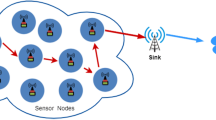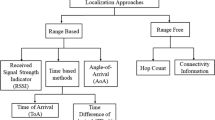Abstract
Capacity analysis is a hot topic in wireless sensor network research. This paper proposes an improved algorithm for the upper bound transmission capacity. Firstly, we introduce the signal-to-interference and noise ratio (SINR) interference model based on the traffic rate. The closed-form expression of the upper-bound transmission capacity was derived based on the Weber model for wireless sensor network, where the node distribution follows a Poisson point process. The effects of parameters such as communication range, density, and SINR threshold were evaluated through sensitivity analysis to determine the upper-bounded transmission capacity. The numerical simulation indicates that the upper limit of transmission capacity can be achieved with an optimum node density though dichotomizing searching algorithm. The results of simulation show capacity increases initially and then decreases as the node density increases








Similar content being viewed by others
Data Availability
This paper has no associated data.
References
Weedage, L., Stegehuis, C., & Bayhan, S. (2023). Impact of multi-connectivity on channel capacity and outage probability in wireless networks. IEEE Transactions on Vehicular Technology, 72(6), 7973–7986.
Li, W., Liu, J., Sheng, M., & Li, J. (2023). The capacity of k-connectivity d-dimensional wireless networks with node failure. Science China Information Science, 66(10), 209302.
Huff, J. D., Leonard, W. B., & Medal, H. R. (2022). The wireless network jamming problem subject to protocol interference using directional antennas and with battery capacity constraints. International Journal of Critical Infrastructure Protection, 39, 100572.
Sarikaya, Y., Atalay, I. C., Gurbuz, O., Ercetin, O., & Ulusoy, A. (2012). Estimating the channel capacity of multi-hop IEEE 802.11 wireless networks. Ad Hoc Networks, 10(6), 1058–1075.
Gupta, P., & Kumar, P. R. (2000). The capacity of wireless networks. IEEE Transactions on Information Theory, 46(2), 388–404.
Stuedi, P., & Alonso, G. (2008). Modeling and computing throughput capacity of wireless multihop networks. Computer Networks, 52(1), 116–129.
Zhao, G., & Liang, Q. (2017). On the uplink outage throughput capacity of hybrid wireless networks with Massive MIMO. Ad Hoc Networks, 58, 62–69.
Baccelli, F., Blaszczyszyn, B., & Mhlethaler, P. (2006). An Aloha protocol for multihop mobile wireless networks. IEEE Transactions on Information Theory, 52(2), 421–436.
Andrews, J. G., Weber, S., Kountouris, M., & Haenggi, M. (2010). Random access transport capacity. IEEE Transactions on Wireless Communications, 9(6), 2101–2111.
Yu, K., Yan, B. W., Yu, J. G., Chen, H. L., & Dong, A. M. (2021). Methods of improving secrecy transmission capacity in wireless random networks. Ad Hoc Networks, 117, 102492.
Khun, A. T. P., Lim, Y., & Tan, Y. S. (2022). Optimal achievable transmission capacity scheme for full-duplex multihop wireless networks. Sensors, 22(20), 7849.
Wang, N., He, J. T., Xiang, S. H., & Yang, J. (2024). Transmission reliability evaluation of the wireless mobile ad hoc network considering the routing protocol and randomness of channel capacity. Quality and Reliability Engineering International, 40(1), 664–680.
Zhou, K. (2020). An upper bound capacity algorithm for multi-hop wireless ad hoc networks. Wireless Personal Communications, 113(1), 439–452.
Choi, Y. H. (2024). Adaptive beamforming for maximum SINR in the presence of correlated interferences. Digital Signal Processing, 146, 104370.
Funding
The authors declare that no funds, grants, or other support were received during the preparation of this manuscript.
Author information
Authors and Affiliations
Contributions
ZW: Conceptualization, Investigation, Undertook the data analysis, Methodology, Writing-original draft. KZ: supervised the data analysis, provided infrastructure, and Writing-reviewing and editing. All authors contributed to and have approved the final manuscript.
Corresponding author
Ethics declarations
Conflict of interest
The authors declare that they have no conflict of interest.
Additional information
Publisher's Note
Springer Nature remains neutral with regard to jurisdictional claims in published maps and institutional affiliations.
Rights and permissions
Springer Nature or its licensor (e.g. a society or other partner) holds exclusive rights to this article under a publishing agreement with the author(s) or other rightsholder(s); author self-archiving of the accepted manuscript version of this article is solely governed by the terms of such publishing agreement and applicable law.
About this article
Cite this article
Wang, Z., Zhou, K. An Improved Upper-Bounded Capacity Algorithm For Wireless Sensor Network. Wireless Pers Commun 135, 419–430 (2024). https://doi.org/10.1007/s11277-024-11046-x
Accepted:
Published:
Issue Date:
DOI: https://doi.org/10.1007/s11277-024-11046-x




